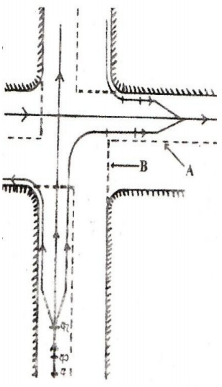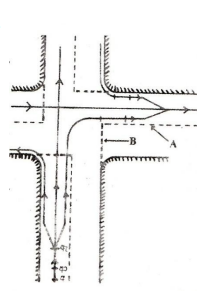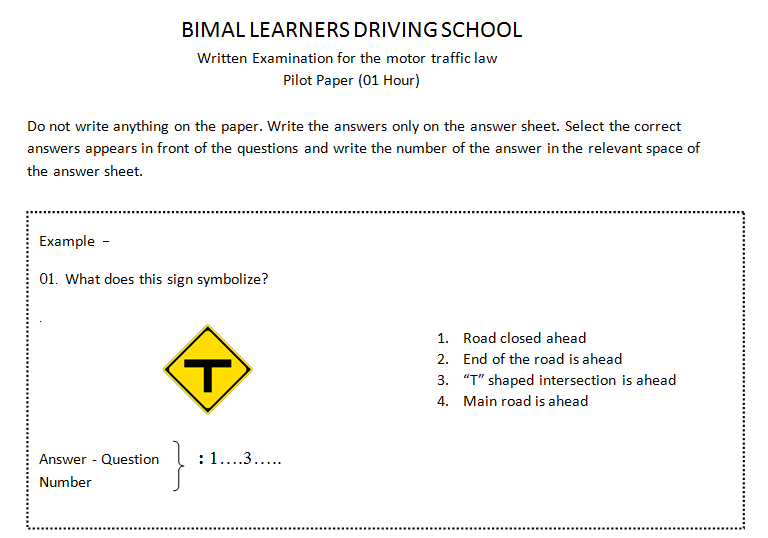1. What does this sign symbolize?
1.Four square junction ahead.
2.Compulsory roundabout.
3.Roundabout ahead.
4.Compulsory roundabout ahead.
|

|
2. In a roundabout?
1.Should always drive from the left.
2.Should always give the priority to the vehicles coming from the left.
3.Should always give the priority to the vehicles coming from the right.
4.Should give the priority to the vehicles coming from the left and right.
|

|
3. What does this sign symbolize?
1.Railway crossing ahead.
2.Level crossing with barrier.
3.Level crossing without barrier.
4.Engine exchange point ahead.
|

|
4. What does this sign symbolize?
1.Hospital ahead.
2.Mosque ahead.
3.Intercepting roads are ahead.
4.Railway crossing ahead.
|

|
5. What does this sign symbolize?
1.Bend to left ahead.
2.Bend to right ahead.
3.Should turn left.
4.Should turn right.
|

|
6. What does this sign symbolize?
1.Narrow road ahead.
2.Prohibited to travel fatty vehicles.
3.Narrow bridge ahead.
4.Dual road ahead.
|

|
7. What does this sign symbolize?
1.Main road ahead.
2.Indicates to give the priority to the vehicles coming from left.
3.Vehicle from the left by road joins the main road.
4.Intersection in the shape of this symbol ahead.
|

|
8. What does this sign symbolize?
1.Elbow bend to the right ahead.
2.Can turn in 'U' shape ahead.
3.Elbow bend to the left ahead.
4.Turn right ahead.
|

|
9. What does this sign symbolize?
1.Pedestrian crossing.
2.Pedestrian crossing ahead.
3.A place to stop the vehicle and allow people to cross the street.
4.Children crossing indication.
|

|
10. What does this sign symbolize?
1.Roundabout ahead.
2.Four square junction ahead.
3.Compulsory roundabout.
4.Compulsory roundabout is ahead.
|

|
11. What does this sign symbolize?
1.No parking on odd days.
2.No parking for vehicles but allowed for loading goods.
3.No parking for vehicles and not allowed for loading goods.
4.No entry for vehicles.
|

|
12. What does this sign symbolize?
1.No entry for vehicles.
2.No parking on odd days.
3.No parking on even days.
4.Overtaking is prohibited.
|

|
13. What does this sign symbolize?
1.Road is closed.
2.No parking.
3.Roundabout ahead.
4.No parking on odd days.
|

|
14. What does this sign symbolize?
1.Entry for the vehicles is prohibited.
2.No parking.
3.No parking for vehicles and not allowed for loading goods.
4.No parking on even days.
|

|
15. What does this sign symbolize?
1.Road is closed.
2.No parking.
3.Roundabout ahead.
4.No entry for vehicles.
|

|
16. What does this sign symbolize?
1.Road is closed.
2.No parking.
3.Overtaking the vehicles.
4.Entry of vehicles prohibited.
|

|
17. What does this sign symbolize?
1.Turn left.
2.Pass in this way.
3.Turn left from the front.
4.Turn back from front.
|

|
18. What does this sign symbolize?
1.Parking for the vehicles is possible.
2.Drive slow because of a possible accident ahead.
3.Signal to stop.
4.Turn right ahead.
|

|
19. What does this sign symbolize?
1.Intersection ahead.
2.Road may be slippery ahead.
3.Overtaking is prohibited.
4.Entry of vehicles and overtaking is prohibited.
|

|
20. Allowed speed limits within the urban city areas are,
1.Motor bike/ dual purpose motor car, trade vehicles, three wheelers respectively 50 mph, 50 mph and 40 mph.
2.Motor bike/ dual purpose motor car, trade vehicles, three wheelers respectively 70 mph, 60 mph and 40 mph.
3.Motor bike/ dual purpose motor car, trade vehicles, three wheelers respectively 50 mph, 50 mph and 40 mph.
4.All the vehicles 50 mph.
|
|
21. When there is a pedestrian crossing,
1.Pedestrians can cross from anywhere within 25 meters of the pedestrian crossing.
2.Pedestrians cannot cross from anywhere within 50 meters of the pedestrian crossing.
3.Pedestrians can cross from anywhere within 50 meters of the pedestrian crossing.
4.Pedestrians can cross only by the pedestrian crossing.
|
|
22. If the yellow bulb lights in the colour lights, vehicles should
1.Ready to go because the green bulb lights next.
2.Stop because the red bulb lights next.
3.Drive forward because the green bulb lights next.
4.Drive fast before the light falls red.
|
|
23. Vehicles should be parked during the night,
1.Facing the direction of vehicles coming.
2.To the direction of vehicles approaching.
3.On your desire.
4.Only on the place reserved for you.
|
|
24. When you find a bend without seeing the road, what you should do is,
1.Blow the horns and keep the same speed.
2.Blow the horns once and lower the speed to stop the vehicle in any emergency.
3.Drive fast without blowing the horns.
4.Always drive by the middle of the road.
|
|
25. What you should do at �Sinhala A� point of turning a vehicle according to the diagram,
1.Show the signals.
2.Watch the mirrors.
3.Lower the speed.
4.Blow the horns.
|

|
26. What you should do at �Sinhala Aa� point of turning a vehicle according to the diagram,
1.Watch the mirrors.
2.Show the signals.
3.Increase the speed.
4.Blow the horns.
|

|
27. What you should do at �Sinhala Ae� point of turning a vehicle according to the diagram,
1.Watch the mirrors.
2.Show the signals.
3.Drive to the relevant lane.
4.Blow the horns.
|

|
28. What indicates at broken lines at point �A� ?
1.Institutional line which prohibits to cross the road.
2.Middle line marked on the center of the road.
3.The line marked to indicate the driving lanes.
4.Indicates an intersection ahead.
|

|
29. What indicates at broken lines at point �B� ?
1.Stopping line of the �Stop� signal.
2.Give away line.
3.The line which provides pedestrians to cross.
4.The line which has divided the road.
|

|
30. When there is an unbroken white line on the road,
1.Overtaking prohibited to cut the white line.
2.Turn to right is prohibited.
3.The line used to divide the road.
4.Used to emphasize the risk of a bend.
|
|
31. When there is two unbroken white lines on the middle of the road,
1.Can turn right.
2.Prohibited to turn right.
3.Can turn right or overtake.
4.Overtaking prohibited to cut the white line and prohibited to turn right.
|
|
32. Fitting an ironic gate to the buffer of the vehicle is,
1.Illegal.
2.More damaging to the other person in an accident.
3.Disturbs to the view of the driver.
4.Possible to unfit the buffer.
|
|
33. Keeping the driving license all the time a person drive is,
1.Required by the law.
2.Sufficient to keep a photocopy.
3.More safer to keep at house to show on any case.
4.Not required by the law.
|
|
34. You can pass the front vehicle by the left side,
1.When the front vehicle has signaled to the right hand side.
2.When it is judged to overtake by left is more safer.
3.Can go by left in whatever the scenario above.
4.Overtaking by left is totally prohibited.
|
|
35. The most important thing to do once you park the vehicle,
1.Pull the hand brake properly.
2.Switch on the parking lights even the daytime.
3.Turn the front tires to the right and stop.
4.Close the doors well with locked up.
|
|
36. Hazard lights should be switched on,
1.When drive forward in an intersection.
2.When overtaking in a risky place of the road.
3.When a vehicle encountered a hazard and parked on the road.
4.When the vehicle carries a patient.
|
|
37. When fuelling to a motor vehicle
1.The engine should be switched on.
2.The engine should be switched off.
3.Check the fuel in the engine is in the accurate level.
4.It should not care about the engine.
|
|
38. The law to be followed in a roundabout is,
1.Give the priority to the vehicle coming from the left.
2.Give the priority to the vehicle coming from the right if there is no any policeman.
3.Give away to the right and vehicles coming from the front.
4.Give away to vehicles coming from left and right.
|
|
39. The first thing to do when overtaking a vehicle,
1.Lower your speed.
2.Watch the back through mirrors.
3.Take the vehicle to the right.
4.Blow the horns.
|
|
40. The maximum time limit to report to the police in an accident,
1.12 hours.
2.24 hours.
3.48 hours.
4.36 hours.
|
|











